-
Catalogue of products
-
- Sale
-
Silver jewellery
-
All in the category Silver jewellery
- Pendants
- Bracelets
- Rings
- Earrings
- Moldavites, czech
- Necklaces
- Golden jewellery
- Torcs - necklaces
- Amber jewelry
- Jewellery sets
- Brooches and buckles
- Silver and stones, jewels
-
Thematic jewelry collections
-
 All in the category Thematic jewelry collections
All in the category Thematic jewelry collections
- Lapponia jewellry
- VIKINGS - bracelets
- Art nouveau jewelry
- Dinosaur pendants
- Mythology collection, ancient cultures
- Nautical silver jewelry
- Filigree and granulated replica jewels
- Garnet jewelry - czech made
- Mystica silver collection - pendants
- Mystica silver collection - earrings
- Mystica collection - silver necklaces
- Historical jewelry
- Zodiac, silver pendants
- Viking jewelry
- Pendants - Historia
-
-
-
Jewellery - bronze, zinc
-
All in the category Jewellery - bronze, zinc
- Amulets and talismans
- Bronze and brass replicas - jewellery
- Gilded jewelry
- Cords, boxes, chains
- Forged jewelry, torcs, bracelets
- Costume jewellery
- Keychains
- Fantasy jewels
- Crowns and tiaras
- Bronze historical jewels
- Chakra, reiki
- Celtic brass jewels, import from Ireland
- Badges, historic jewels
- Scottish clan badges
- Original celtic jewelry
-
-
Replicas - Swords, Axes, Knives
-
All in the category Replicas - Swords, Axes, Knives
- Sharp Blades - throwing knives
- Swords
- Axes, poleweapons
- Daggers
- Knives
- FakeSteel armory
- Maces, war hammers
- Saex knives, scramasax
- Lances, spears
- Archery
- Damascus steel knives
- Falchions and Lange Messers
- Swiss army knives
- HMB - swords, falchions, axes, weapons
- Firearms, cannons
- Viking knives
- Hunting hangers
- Pillow Fight Warriors
- Knives - accessories, sharpeners
- Kitchen knives
-
-
Armour Helmets, Shields
-
T-shirts, Boots
-
Ceramics, Glass
-
Leather Products
-
All in the category Leather Products
- Belts
- Bags, sporrans
- Belt accessories
- Hair clips, accessories, jewellery
- Wallets
- Wristbands
- Leather stamps
- Leather material, furs
- Custom made belts
- Leather masks
- Bottles, hip flasks
- Keychains, whips, other
- Leather care, dyes and stains
- Historical shoemaking
- Leathercraft tools
- Riding shop - horse saddles
- Falconry
- Furs, Reindeer Skins
-
-
Horn Products
-
Smithy Works, Coins
-
Bushcraft, Living History, Crafts
-
All in the category Bushcraft, Living History, Crafts
- Bushcraft
- Forged carving chisels
- Kuksa - Finnish dishes
- Leather, furs, skins, pergamens
- Europe
- Drugstore
- Historical glass beads, replica
- Rocailles Czech glass beads
- Deer antler products
- Craftsman tools, acessory
- Prehistoric ages
- Native americans
- Old Slavs
-
-
 Coins
Coins
-
Shoes, Costumes
-
Drums, Flutes
-
Historical Board Games
-
Pagan decorations
-
All in the category Pagan decorations
- Figures, lamps, cups
- Vánoční ozdoby
- Boxes, pencil cases
- Mugs, goblets, scarves
- Dragons
- Antler furniture, lamps
- Animal figures
- Historical miniatures
- Wall plaques, clock
- Pictures
- Products from antler, wood
- Exterior decorations
- Scrolls, posters, puzzle
- Tin figures, goblets
-
-
Woolen products, Ireland
-
 Wood
Wood
-
 Wargaming
Wargaming
-
Licensed Merch - films, games
-
All in the category Licensed Merch - films, games
- Warhammer 40K
- 2001 Space Odyssey
- AC/DC
- Alien
- Antman
- Assassin's Creed
- Asterix
- Avatar
- Avengers - Infinity War
- Back to the Future
- Batman
- Beetlejuice
- Big Bang Theory
- Blade Runner
- Bud Spencer - Terence Hill
- CBGBs
- Clockwork Orange
- Deadpool
- Deep Purple
- E.T. the Extra-Terrestrial
- Frank Zappa
- FULL METAL JACKET
- GAME OF THRONES
- Ghostbusters
- Godfather
- Gremlins
- GUARDIANS OF THE GALAXY
- HAN SOLO MOVIE
- Harry Potter
- Iron Maiden
- IT
- Jaws
- James Bond 007
- Jurassic Park
- King Kong
- Knight Rider
- KISS
- Led Zeppelin
- LOONEY TUNES
- LORD OF THE RING
- Magic the Gathering
- Marvel
- VIKINGS
- Metallica
- Metro Exodus
- Mortal Kombat
- Mr Pickles
- NASA
- Nirvana
- Peaky Blinders
- Pearl Jam
- Pink Floyd
- Planet of the Apes - Planeta opic
- Pokémon
- Predator
- Queen
- Rambo
- Rick and Morty
- Robocop
- Spiderman
- Star Wars
- Suicide Squad
- Superman
- Teenage Mutant Ninja Turtles - Želvy ninja
- The Doors
- The Witcher
- Thor Ragnarok
- Vikings
- World of Warcraft
- Rocky
- Terminator
- Dračí Hlídka
-
-
 Magic
Magic
-
Books, Maps, Stickers
-
Historical Tents
-
Sculptures, Garden Decor
-
 Mead, Honey
Mead, Honey
-
 Moldavites, minerals, fossils
Moldavites, minerals, fossils
-
Cosmetics
-
Archeology, Geology
-
Interior design
-
 Yule decorations, Glass Beads
Yule decorations, Glass Beads
-
Aromatherapy
-
FILM and props
-
 Outdoor - Bushcraft
Outdoor - Bushcraft
- Naav
- Arma Epona
- WHOLESALE lots
- Gift Certificates
- SPECIAL OFFER, discounts
-
- Log in
- Create an account
- Wholesale
- Contact us
- Country (English)
- Currency ($ - USD)


Nothing was added in your basket.
- Blog
- Middle Ages
- Armour of the Black Prince
Armour of the Black Prince
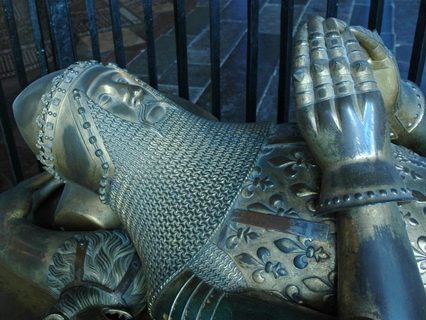
Armour of the Black Prince
Armour of the Black Prince
Edward of Woodstock, also known as the "Black Prince", is now almost a legendary historical person and one of the leading characters of the Hundred Years' War (1337-1453) between England and France. The Black Prince himself, although the first-born son of Edward III and heir to the throne, did not receive the royal crown, for death overtook him during his father's lifetime. Just the prince's son became a king as Richard II.

Edward of Woodstock, however, has gone down in history even without the royal crown, as a brave and capable military leader who did not hesitate to mix chivalrous warfare with purely pragmatic military methods. It was this that won him victory and glory in the battles of Crécy (1346) and Poitiers (1356). It should be noted that the nickname 'Black Prince' has not been satisfactorily explained to this day. For first time it is documented in written sources only in the mid-16th century and, according to an unverified report, it was actually created during the Prince's lifetime when the French were supposed to have referred to him as such - presumably on the basis of the crushing defeats he inflicted to the French in battles and possibly also in connection with the fiscal oppression and massacres of the civilian population that were carried out on the Prince's orders. According to another non-confirmed theory the nickname may have been based on the fact that the plates of the prince's armour were blackened.
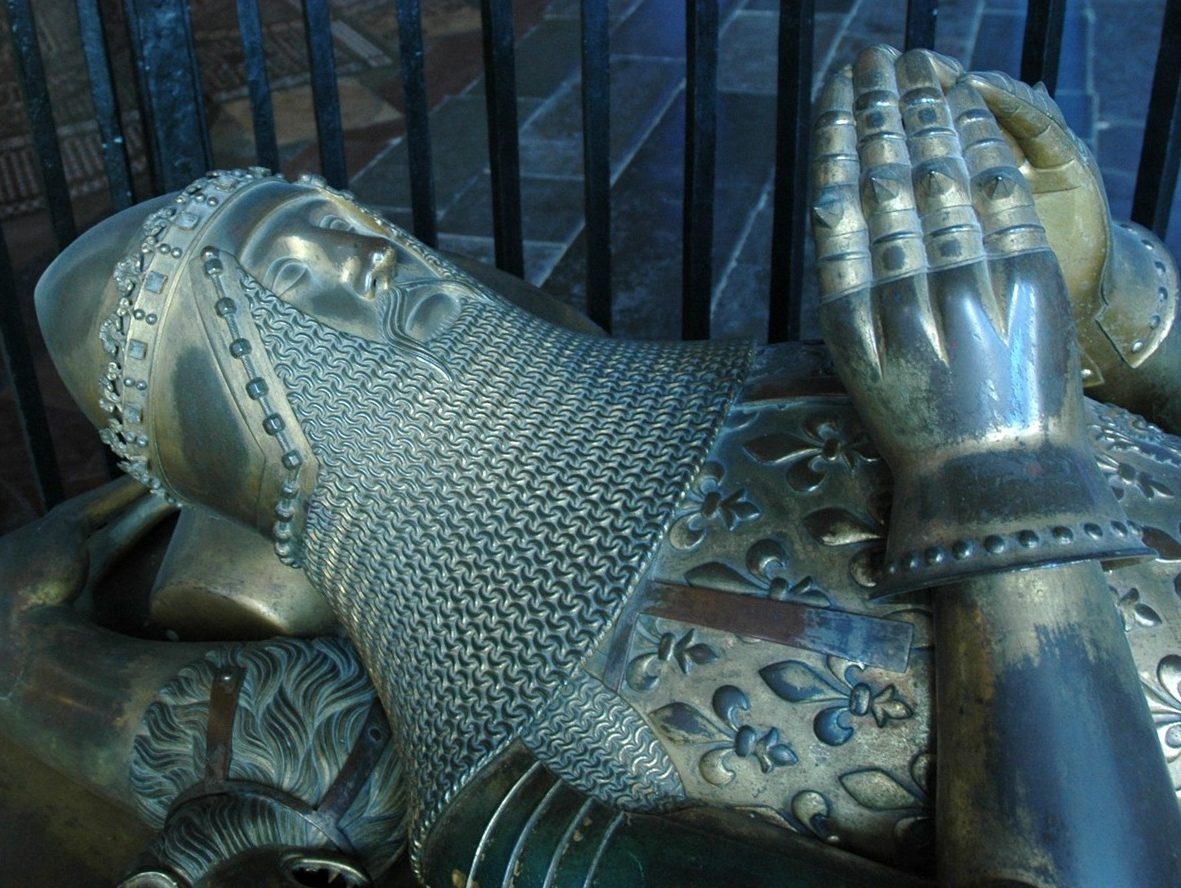
In Canterbury Cathedral we can still admire the tombstone with the plastic bronze relief of the black prince, depicted in full armour. Edward of Woodstock was depicted in the armour quite typicall for a mounted heavy cavalryman of the period of his death (1376). However, it is possible that such armour was worn by the prince at the time of his greatest glory in the battles of Crécy and Poitiers. There is pictorial evidence that armour of this design existed as early as the mid-14th century, but at that time it was a new fashionable hit, which could be accesible only to the kings, men members of the royal house and to the houses of high nobility. It was only at the time of the Prince's death that such armour (in a simpler design) was available also to the members of the lesser nobility.
The Prince's armour on the tombstone is characterised by complete plate protection of the upper and lower limbs. The clasped hands are protected by gauntlets of the so-called hourglass type (klepsydra), which came into use around the middle of the 14th century and were still worn in the early 15th century. The fitted silhouette of the torso with a stylized surcoat suggests that the prince wore either a fitted coat of plates armour underneath or one of the first type of the cuirasses, which gradually begin to appear at this time. The armour, however, also shows features that point to an earlier period – the shoulder guards are not accompanied by targets to protect the underarm sockets, which were quite common from the last quarter of the 14th century onwards, and the prince has a great helmet under his head. In the first half of the 14th century great helmet was worn over the lower helmet – originally called the skull helmet, later the basinet, which the prince wears on his head with a decorative crown - and during the second half of the 14th century it was replaced by new types of helmets with a movable visor, the so-called „Hounskull“ or later "Great basinet".
And what to read next?
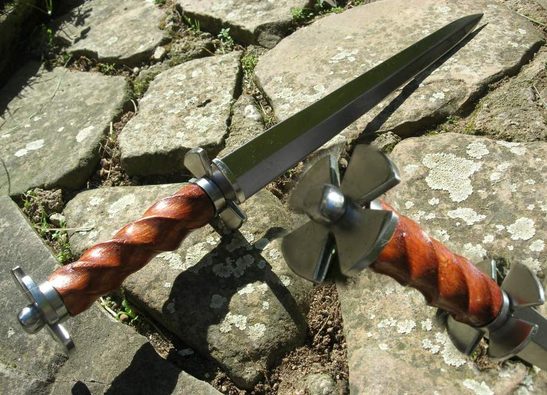
Rondel Dagger
When it comes to short sidearms of the late Middle Ages, it…
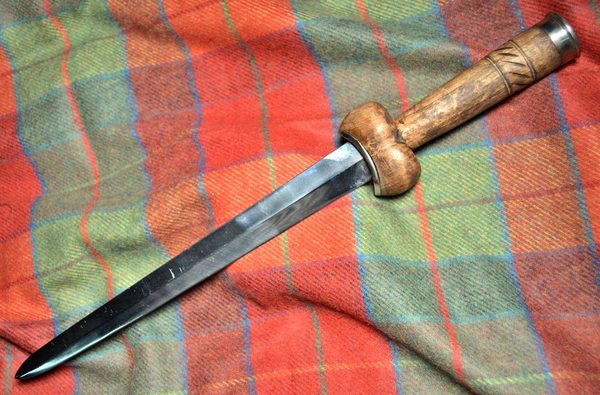
Kidney dagger – Bollock Dagger
The dagger was, alongside the knife, a basic and usually…

The Witcher
When Polish writer Andrzej Sapkowski finished the first…
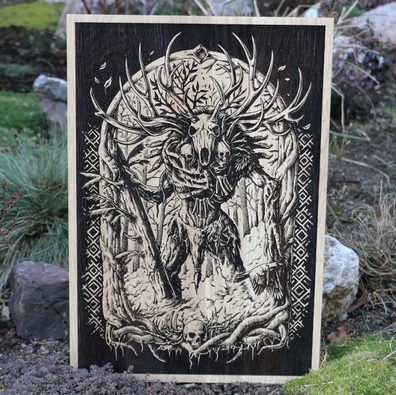
Leshy - Slavic forest spirit
Leshy - Slavic forest spirit


